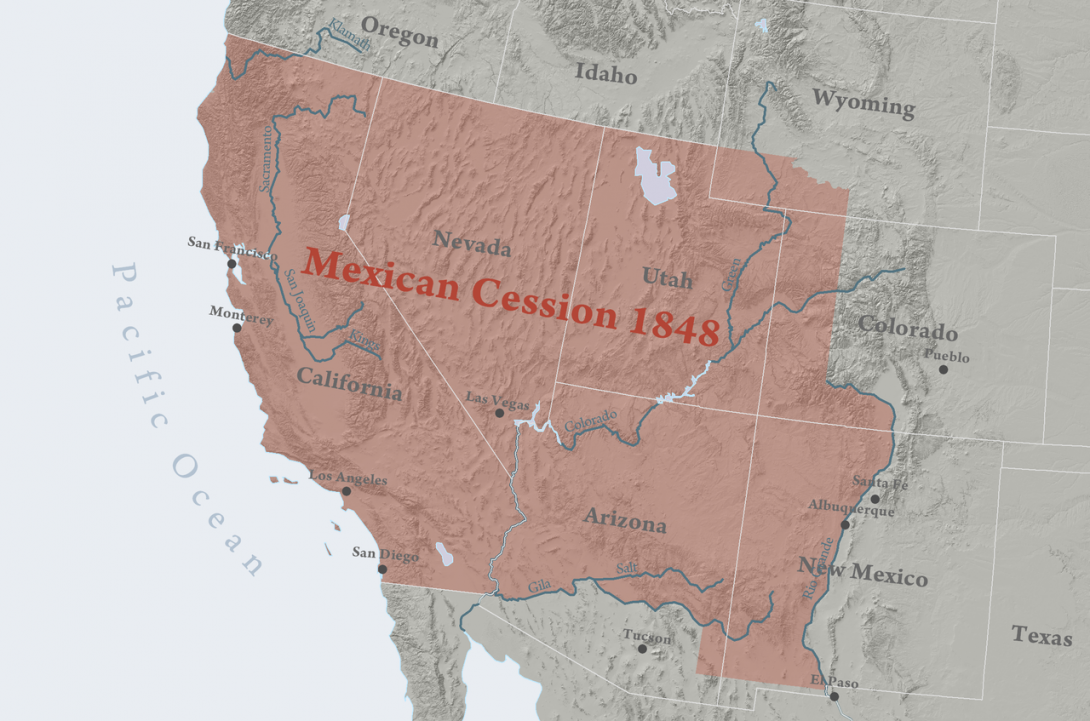Treaty of Guadalupe Hidalgo
Full Article
Signed on February 2, 1848, the Treaty of Guadalupe Hidalgo ended the Mexican-American War (1846–48). In the treaty, the Republic of Mexico agreed to cede 55 percent of its territory, some 525,000 square miles, to the United States. This land eventually became the present states of Arizona, California, Nevada, New Mexico, and Utah, as well as a large portion of western and southern Colorado.
Under the treaty, Mexican citizens living in the ceded territory became US citizens. The treaty paved the way for Hispanos (former citizens of Mexico and their descendants) to immigrate to what is now southern Colorado. There, in the San Luis Valley, they established the first permanent towns and irrigation canals in what became Colorado. After the war, the US government also broke up land grants in southern Colorado that were previously awarded by the Mexican government.
Origins
The Republic of Mexico gained independence from Spain in 1821. The new nation immediately established trade relations with the United States. A steady stream of goods and livestock traveled between the countries via the Santa Fé Trail, part of which crossed what is now southern Colorado. However, tensions between the nations began to escalate, especially in Texas, where immigrant American slaveholders ran up against Mexico’s antislavery laws. Anglo-Texans seceded from Mexico in 1836, creating the independent Republic of Texas, which was formally annexed by the United States in 1845.
As Spain had before it, Mexico tried to secure its northern frontier by encouraging citizens to settle there. It established communities in northern New Mexico and attempted to settle the San Luis Valley. However, American Indians, especially the Comanche, Apache, and Ute, drove away would-be colonists and controlled much of Mexico’s northern reaches in the 1840s. Sensing an opportunity to gain new territory for the United States, President James K. Polk goaded Mexico into war in 1846 by sending troops into a disputed boundary zone between the two nations.
With northern Mexico decimated by Comanche attacks, the US Army swiftly moved through the Mexican Republic, while the American Navy blockaded important ports such as Veracruz. US forces captured Mexico City on September 15, 1847. The Treaty of Guadalupe Hidalgo was signed early the next year in Villa Guadalupe Hidalgo, a town north of Mexico City.
Effects in Colorado and Beyond
To many Americans at the time, the addition of so much land opened new opportunities, but it also renewed the competition between those who sought to expand slavery to the western territories and those who sought to stop its spread or abolish it altogether. This tension eventually led to the American Civil War in 1861. The new lands also presented another challenge because they were already occupied by hundreds of distinct Indian nations, none of whom were prepared to allow Americans unchecked influence over their homelands.
The Treaty of Guadalupe Hidalgo led to the first permanent towns in what became Colorado, largely because it allowed the US government to begin treating with local Indian nations. In 1849 local Ute bands signed the Treaty of Abiquiú, which allowed Hispano and white farmers, ranchers, and merchants to live in the San Luis Valley. The Abiquiú Treaty also gave the United States permission to set up military forts in the valley. In 1852 Fort Massachusetts was built on the valley’s eastern edge; it was eventually moved and renamed Fort Garland in 1858.
After 1849 Hispano families began moving north from New Mexico into the San Luis Valley. In 1851 they established San Luis, Colorado’s oldest continuously occupied town. In 1854 Mexican-American War veteran Lafayette Head brought Hispano families from Abiquiú, New Mexico, to found the town of Guadalupe in present Conejos County. In 1858 Hispano residents built Colorado’s first Catholic church in the village of Conejos. Many of these early residents brought with them enslaved indigenous people, especially Navajos and Apaches. Indigenous slavery, an institution inherited from the Spanish occupation of the American Southwest, still existed in the San Luis Valley into the 1860s.
Legacy
Besides greatly increasing the size of the nation, the Treaty of Guadalupe Hidalgo established the foundation for the modern economic, political, and cultural development of southern Colorado. However, this development came at the expense of the Ute and other American Indians, who were forced to give up much of their ancestral homelands and subjected to slavery and cultural genocide. Today, the Utes still live in southwest Colorado, and Hispano families and communities remain an integral part of southern Colorado’s economy and identity.










































